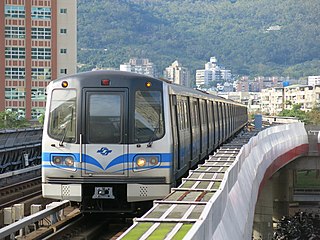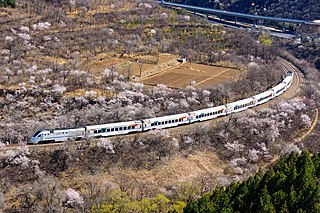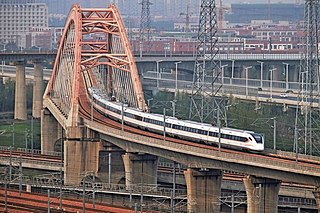
Taipei Mass Rapid Transit (MRT), branded as Metro Taipei, is a rapid transit system serving the capital Taipei and New Taipei City in Taiwan, it is one of the world's busiest rapid transit systems.

Taipei Main Station is a major metro and railway station in the capital Taipei, Taiwan. It is served by Taipei Metro, the Taiwan High Speed Rail, and Taiwan Railway. It is also connected through underground passageways to the terminal station of Taoyuan Airport MRT and the Taipei Bus Station. It is the busiest station in Taiwan.

Taiwan Taoyuan International Airport MRT, commonly known as the Airport MRT, is a rapid transit line of the Taoyuan Metro that connects the municipalities of the capital Taipei, Taoyuan and New Taipei with Taoyuan International Airport. The 51.33 km (31.89 mi) line, from Taipei Main Station to Laojie River, has 22 stations and began commercial service on 2 March 2017.

Kaohsiung Main Station is a railway and metro station in Sanmin District, Kaohsiung, Taiwan served by the Taiwan Railways and Kaohsiung Rapid Transit. It is one of four special class stations, the highest class with the most services. It is currently undergoing reconstruction, scheduled to be complete in 2024.

Taichung HSR is a railway and metro station in Wuri District, Taichung, Taiwan. It is served by Taiwan High Speed Rail and the Green Line of the Taichung Metro. The station is adjacent to Xinwuri Station of Taiwan Railway Administration.

Line S2 of Beijing Suburban Railway (BCR) is a commuter rail line in Beijing. The main line runs from Huangtudian railway station in Changping District to Yanqing railway station in Yanqing District, following the old Beijing–Baotou railway, and provides faster, more frequent and convenient service than preexisting trains. The line is 108.3 kilometres (67.3 mi) in length. The train locomotives are marked "Great Wall".

The Taoyuan Metro is a rapid transit system serving Taoyuan City, as well as parts of New Taipei City and Taipei City, in Taiwan. The most recently proposed network includes 11 lines and extensions, of which 2 are now under construction. The Taoyuan Airport MRT is the only line currently in operation. The system opened with the opening of the first line in the system, Taoyuan Airport MRT, for trial passenger service on 2 February 2017 and revenue passenger service on 2 March 2017.

Line 9 is a rapid transit line of the Tianjin Metro. It spans 52.8 km (32.8 mi) with 21 stations, connecting the urban area of Tianjin with Binhai New Area, a new area within the jurisdiction of Tianjin Municipality. The one-way journey time is approximately one hour.

Sizihwan is a terminus of the Orange line and adjacent to Circular light rail Hamasen station of Kaohsiung Metro. It is located in Hamasen of Gushan District, Kaohsiung, Taiwan. Its name is derived from Sizihwan, a nearby scenic area.

Jinhua railway station, formerly Jinhua West railway station, is a railway station on the Shanghai-Kunming railway and the Hangchangkun Passenger Railway located in Wucheng District, Jinhua, Zhejiang, People's Republic of China.

Wuxi railway station is a railway station of Jinghu railway and Shanghai-Nanjing Intercity Railway, located in Chong'an District, Wuxi, Jiangsu, is a special station under the jurisdiction of China Railway Shanghai Bureau Group Co., Ltd. The main lines are the Beijing-Shanghai Railway and the Shanghai-Nanjing Intercity Railway.

The Fuzhou Metro is a rapid transit system in Fuzhou Metropolitan Area, Fujian Province, China. The first line was planned to open in 2014. Due to the construction difficulties and accidental archaeologic finding, the southern section was delayed to 2016 and the northern section was delayed to 2017. Currently, the Fuzhou Metro Network consists of five lines. They are operated by Fuzhou Metro Group, and Fuzhou CETC Rail Transit Company, respectively.

Beijing Fengtai railway station is a railway station located in the Fengtai District of Beijing. It was renamed from Fengtai railway station to Beijing Fengtai railway station in 2021. The new railway station opened on 20 June 2022.

The Zhengding Airport railway station is a station on the Beijing–Guangzhou–Shenzhen–Hong Kong high-speed railway. It is located in Xinchengpu Town in Zhengding County, Shijiazhuang, Hebei Province, near Shijiazhuang Zhengding International Airport.

Lanzhou Metro or Lanzhou Rail Transit is a rapid transit system in Lanzhou, Gansu, China.

Taiwan Railway (TR) is a state-owned conventional railway in Taiwan. It is operated by the Taiwan Railway Corporation under the supervision of the Ministry of Transportation and Communications, responsible for managing, maintaining, and running conventional passenger and freight railway services on 1,097 km (682 mi) of track in Taiwan. Passenger traffic in 2018 was 231,267,955.

Zhengzhou–Kaifeng intercity railway, abbreviated as the Zhengkai intercity railway, is a higher-speed intercity railway in Henan, China, connecting Zhengzhou and Kaifeng. It is part of the larger Central Plain Metropolitan Intercity Rail network. Construction commenced on December 29, 2009. With a designed top speed of 160 km/h (99 mph), it is built as a double tracked electrified passenger dedicated line. Total length of this project is 50.33 kilometres (31.27 mi), costing an estimated 5.5 billion yuan to construct. Some trains through operate to Zhengzhou Xinzheng Airport via the Zhengji ICR or to Jiaozuo via the Zhengjiao ICR.

Huairou–Miyun Line of Beijing Suburban Railway (BCR), or Huaimi Line, is a commuter rail line in Beijing. It runs from Beijing North in Xicheng District to Gubeikou in Miyun District. The line is 144.6 km (89.9 mi) in length with 7 stations.

Songjiang Tram is a light rail tramway in Shanghai, China. The system consists of two lines totaling 31 km (19 mi) with 42 stations. Unlike the Zhangjiang Tram, Songjiang trams use centenary power supply and steel-wheeled rail systems. Most of them use independent rights of way. The intersection signal lights were adjusted through the system to make them pass first, and the running speed reaches 25-30km/h. Trains run from 6:00 till 22:00. With further extension of the network public transport modal split in Songjiang is expected from the current 23% to 40%.

Sanyuanqu railway station is a railway station in Sanyuan District, Sanming, Fujian, China.
























